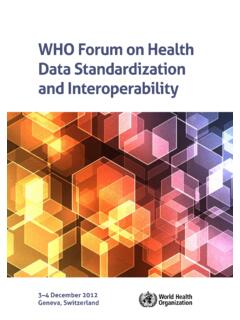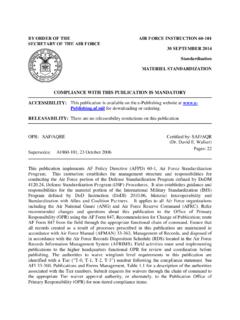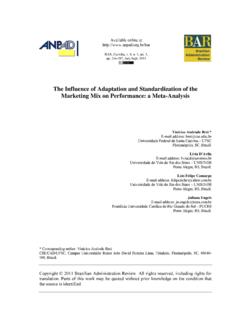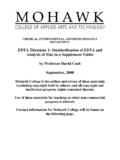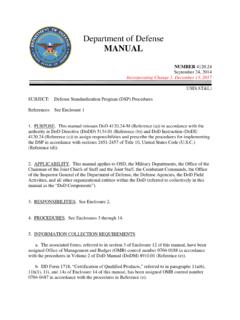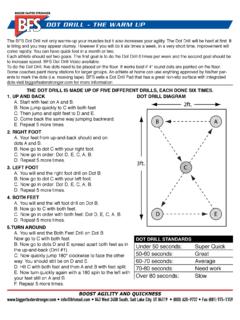Transcription of Annex 4 - WHO
1 153 Annex 4 Recommendations to assure the quality, safety and efficacy of influenza vaccines (human, live attenuated) for intranasal administrationIntroduction 156 General considerations 156 Part A. Manufacturing recommendations Definitions International name and proper name Descriptive definition International standards Terminology Background on influenza vaccine (human, live attenuated) production General manufacturing recommendations Procedures and facilities Eggs and cell cultures Control of source materials Choice of vaccine strain Substrate for virus propagation Master cell bank and manufacturer's working cell bank Cell culture medium Virus strains Control of vaccine production Production precautions Production of monovalent virus pool Control of monovalent virus pools Control of final bulk Filling and containers Control tests on final product Identity Sterility Infectivity (potency)
2 Endotoxin Residual moisture of lyophilized vaccines Inspection of final containers Records Retained samples Labelling Distribution and transport 193154 WHO Technical Report Series No. 977, 2013 WHO Expert Committee on Biological standardization Sixtieth Stability Stability testing Storage conditions Expiry date 194 Part B. Nonclinical evaluation of new influenza vaccines (human, live attenuated) General remarks Process development and product characterization Nonclinical toxicity and safety testing Preclinical toxicity Preclinical safety testing Nonclinical immunogenicity and efficacy Nonclinical immunogenicity Nonclinical efficacy 200 Part C. Clinical evaluation of new influenza vaccines (human, live attenuated) General remarks Clinical evaluation strategy Clinical studies for licensure Post-marketing studies Clinical safety Initial safety assessment Expanded safety assessment Clinical efficacy and immunogenicity Clinical efficacy studies Clinical correlates of protection Clinical serological parameters Other clinical measures of immunity Evaluation in special populations Children The elderly Risk groups Strain change considerations for seasonal vaccines Vaccines intended for pandemic influenza 209 Part D.
3 Recommendations for national regulatory authorities General remarks Release and certification Manufacturing changes 211 Authors 211 Acknowledgements 213 References 213 Appendix 1 Summary protocol for influenza vaccines (human, live attenuated) 218 Annex 4155 Appendix 2 Reference laboratories 224 Appendix 3 Model certificate for the release of influenza vaccine (human, live attenuated) for intranasal administration 226 Recommendations published by WHO are intended to be scientific and advisory in nature. The parts of each section printed in type of normal size have been written in such a form that, should a national regulatory authority so desire, they may be adopted as they stand as definitive national requirements or used as the basis for such requirements.
4 The parts printed in smaller type are comments and recommendations intended as guidance for manufacturers and national regulatory authorities that may benefit from additional information. It is recommended that any modifications be made only on condition that they ensure that the vaccine is at least as safe and efficacious as that prepared in accordance with the recommendations set out below. In order to facilitate the international distribution of vaccine made in accordance with these recommendations, a summary protocol for the recording of results of tests is given in Appendix 1. The terms national regulatory authority and national control laboratory as used in these recommendations always refer to the country in which the vaccine is Technical Report Series No.
5 977, 2013 WHO Expert Committee on Biological standardization Sixtieth reportIntroduction The WHO requirements for influenza vaccine (live) date from 1979 (1). The purpose of these updated recommendations is to provide vaccine manufacturers and national regulatory authorities with applicable considerations and guidance in developing specific processes for assuring the quality, safety and efficacy of influenza vaccines (human, live attenuated) for intranasal administration, including their nonclinical and clinical recommendations apply to influenza vaccines (human, live attenuated) for intranasal administration using embryonated hen s eggs as substrates. It is expected that these vaccines will be produced using cell cultures as substrates and guidance is also provided for this eventuality.
6 These recommendations are not specific for a particular form of influenza vaccine virus attenuation used to prepare the final influenza virus vaccine product. They should apply to the production and quality control of viruses intended for use in the manufacture of influenza vaccine (human, live attenuated) for intranasal administration, including reassortant viruses prepared either by classical reassortment methods or by reverse genetics recommendations (with possible modifications) are meant to apply to influenza vaccines (human, live attenuated) for intranasal administration, produced with seasonal vaccine strains for use during the inter-pandemic period as well as vaccines produced with strains for use during pandemics. However, these recommendations cannot anticipate every situation that may arise, and alternative considerations may be needed for specific public health circumstances.
7 The first draft of this document was based on the requirements for influenza vaccines (live) from 1979 (1) and on the recommendations for the production and control of influenza vaccines (inactivated) (2). Sections on the preclinical, nonclinical and clinical evaluation were added to the updated recommendations to assure the quality, safety and efficacy of influenza vaccines (human, live attenuated) for intranasal administration. The section on testing animals for adventitious agents, which was included in the 1979 requirements, was removed from the updated recommendations as animal testing for that purpose is no longer generally recommendations in this document do not apply to the potential vector systems ( other viral or bacterial hosts) that could be used to deliver the antigenic components of influenza viruses.
8 Further recommendations may be developed in the future as additional strategies emerge for immunological control of influenza virus considerationsInfluenza is a significant cause of morbidity and mortality and each year has major social and economic impact throughout the world. Influenza viruses Annex 4157undergo continuous evolutionary change, which makes control of influenza challenging. In order to assist national regulatory authorities and manufacturers in control efforts, WHO provides annual reviews of epidemiological information and recommendations on the influenza viruses to use in vaccines in countries of the northern and southern hemispheres (3).Many people require medical treatment and/or hospitalization, and excess mortality often accompanies viral influenza epidemics; the vast majority of those affected are elderly.
9 Because the elderly constitute the most rapidly increasing sector of the population in many countries, the epidemiology of viral influenza can be expected to change accordingly, especially in high-income countries. Although mortality is typically highest among the elderly, influenza epidemics originate in settings that bring together immunologically susceptible individuals who are capable of spreading infection rapidly throughout a community, such as school-aged children. Infants are particularly susceptible to the severe consequences of viral influenza infections, but children of all ages may experience complications of influenza, including pneumonia and present, the most generally available means of influenza prophylaxis is vaccination. Potential means of prevention, other than personal and societal hygienic measures, include antiviral medications.
10 However, the indefinite nature of exposure to influenza virus, which could necessitate protracted compliance with an antiviral medication regimen, as well as issues of potential or real emergence of drug-resistant virus strains, has prompted strategies to reserve chemoprophylaxis for specific circumstances (4, 5).Inactivated influenza vaccines, which function mainly by inducing IgG antibodies specific for influenza virus haemagglutinins, have a long and solid record of use. The interest in live influenza virus vaccines stems from their potential to permit simplified administration by intranasal drops or spray (6). In addition, they stimulate not only systemic humoral immunity but also local and systemic immune protective mechanisms, including mucosal IgA antibodies and cellular immunity.











